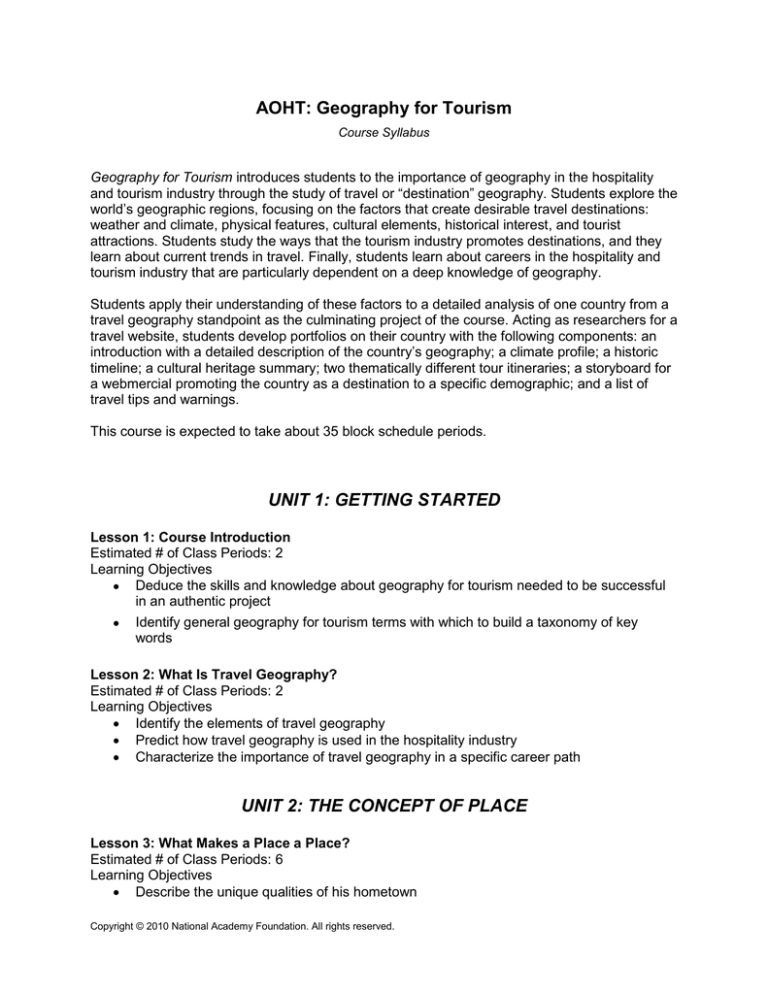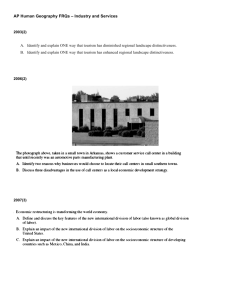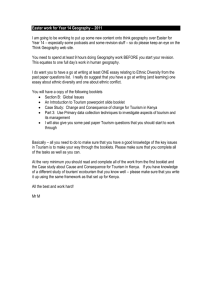
AOHT: Geography for Tourism
Course Syllabus
Geography for Tourism introduces students to the importance of geography in the hospitality
and tourism industry through the study of travel or “destination” geography. Students explore the
world’s geographic regions, focusing on the factors that create desirable travel destinations:
weather and climate, physical features, cultural elements, historical interest, and tourist
attractions. Students study the ways that the tourism industry promotes destinations, and they
learn about current trends in travel. Finally, students learn about careers in the hospitality and
tourism industry that are particularly dependent on a deep knowledge of geography.
Students apply their understanding of these factors to a detailed analysis of one country from a
travel geography standpoint as the culminating project of the course. Acting as researchers for a
travel website, students develop portfolios on their country with the following components: an
introduction with a detailed description of the country’s geography; a climate profile; a historic
timeline; a cultural heritage summary; two thematically different tour itineraries; a storyboard for
a webmercial promoting the country as a destination to a specific demographic; and a list of
travel tips and warnings.
This course is expected to take about 35 block schedule periods.
UNIT 1: GETTING STARTED
Lesson 1: Course Introduction
Estimated # of Class Periods: 2
Learning Objectives
Deduce the skills and knowledge about geography for tourism needed to be successful
in an authentic project
Identify general geography for tourism terms with which to build a taxonomy of key
words
Lesson 2: What Is Travel Geography?
Estimated # of Class Periods: 2
Learning Objectives
Identify the elements of travel geography
Predict how travel geography is used in the hospitality industry
Characterize the importance of travel geography in a specific career path
UNIT 2: THE CONCEPT OF PLACE
Lesson 3: What Makes a Place a Place?
Estimated # of Class Periods: 6
Learning Objectives
Describe the unique qualities of his hometown
Copyright © 2010 National Academy Foundation. All rights reserved.
Academy of Hospitality & Tourism: Geography for Tourism
Summarize the unique qualities of a world destination
Compare and contrast her hometown to a world destination
Categorize the characteristics of a world destination according to components of travel
geography
Lesson 4: A Sense of Place: Personal History and Culture
Estimated # of Class Periods: 6
Learning Objectives
Demonstrate the ability to conduct an interview
Summarize a personal interview about a family or community member’s cultural heritage
Identify the personal importance of an artifact representing an aspect of the student’s
cultural heritage
Create a cultural heritage visual representation
UNIT 3: GLOBAL GEOGRAPHY
Lesson 5: Global Geography
Estimated # of Class Periods: 6
Learning Objectives
Evaluate how different types of maps can be used to present various types of
information
Identify major geographic features around the world
Create a map for a major world region
Lesson 6: Physical Geography and Tourism
Estimated # of Class Periods: 6
Learning Objectives
Describe the major geographic features of a particular country
Evaluate the relationship between physical geography, culture, history, and tourism at a
particular destination
Compare and contrast features of different travel websites
Identify the characteristics of successful travel websites
Lesson 7: Weather and Climate of a Place
Estimated # of Class Periods: 6
Learning Objectives
Display understanding of the concepts of climate and climate change
Identify the climate zone to which a particular country belongs
Evaluate how a climate zone may be affected by global warming
Characterize the five climate zones
Evaluate ways we can affect the process of climate change
UNIT 4: HISTORY, CULTURE, AND ATTRACTIONS
Lesson 8: History of a Place
Estimated # of Class Periods: 6
Copyright © 2012 National Academy Foundation. All rights reserved.
-2-
Academy of Hospitality & Tourism: Geography for Tourism
Learning Objectives
Describe the impact of history on the popular perception of several American cities
Identify major historical events in a particular country’s history
Develop a timeline of a specific country’s history
Evaluate the most important events for potential inclusion in a historical tour of a specific
country
Lesson 9: Culture of a Place
Estimated # of Class Periods: 6
Learning Objectives
Compare and contrast history and culture
Make inferences about the information a tourist needs by reading actual travel guide
information
Evaluate specific cultural elements for inclusion in a report for tourists about a particular
country
Develop a report on a specific element of a country’s culture
Lesson 10: Attractions and Geography
Estimated # of Class Periods: 5
Learning Objectives
Classify attractions by type
Evaluate how geography affects attractions
Display understanding of the relationship between tourism and attractions
Identify popular attractions of one or more US state
Summarize what makes an attraction unique or interesting
UNIT 5: A TRAVELER’S PERSPECTIVE
Lesson 11: Travelers and Tours
Estimated # of Class Periods: 5
Learning Objectives
Display understanding of target markets for tourism
Evaluate how travelers’ characteristics and motivations place them in specific target
markets
Identify a wide range of specialty tours
Design a tour itinerary to appeal to a specific target market
Lesson 12: Travelers and Trends in Tourism
Estimated # of Class Periods: 6
Learning Objectives
Deduce likely target markets of destinations by analyzing webmercials
Evaluate how trends affect different types of travelers
Design a storyboard for a commercial to be streamed on the web that promotes a
particular country
Copyright © 2012 National Academy Foundation. All rights reserved.
-3-
Academy of Hospitality & Tourism: Geography for Tourism
Lesson 13: Travel Barriers
Estimated # of Class Periods: 3
Learning Objectives
Evaluate how travel barriers affect specific types of travelers
Identify what barriers exist to travel to a specific destination
Create effective tips and warnings to prepare travelers to visit a specific destination
UNIT 6: CAREER DEVELOPMENT IN TRAVEL GEOGRAPHY
Lesson 14: Working in Tourism
Estimated # of Class Periods: 4
Learning Objectives
List the types of jobs that are available that require knowledge of travel geography
Describe entry-level jobs in geography-related industries and corresponding
qualifications
Evaluate which jobs are most suitable based on personal interests and skills
Develop effective responses to common job interview questions
Lesson 15: Final Presentation and Course Closure
Estimated # of Class Periods: 5
Learning Objectives
Demonstrate the ability to give a professional presentation
Evaluate personal experience and performance in the course
Summarize key learning across the whole subject of geography for tourism
Copyright © 2012 National Academy Foundation. All rights reserved.
-4-






